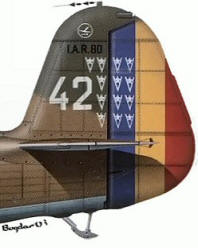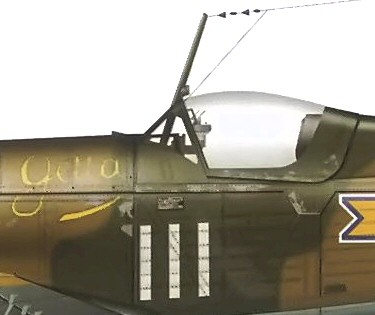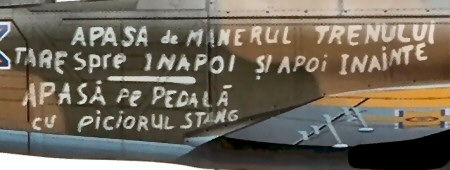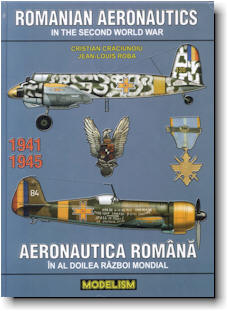Camouflage & Markings
by Doru Sicoe
artwork by Bogdan Patrascu
IAR 80 no. 42. of Grupul 8
flown by lt. av. Ion Micu in Summer 1941.
Micu was the top-scoring IAR 80 pilot during this early stage of the war.
 Romania has a strong aeronautic tradition reaching back to the beginning of the 20th century. In the early days of aviation, three Romanians left their mark in the world’s aviation history: Traian Vuia, Aurel Vlaicu and Henri Coandă. All three of them built original aircraft, showing remarkable innovating potential, way ahead Romania’s economic possibilities. Vuia built and flew the first automobile-airplane hybrid ever – the Vuia 1 – lifting above the ground with its own powers on the 18th of March 1906, near Paris. The Vlaicu 1 was unique in its tandem propeller layout, reminiscent of the later Do-335. The plane piloted by Aurel Vlaicu himself received five prizes at the 1912 international aviation contest in Aspern-Vienna. Henri Coandă, son of a Romanian general, is the father of the jet propulsion and the first constructor that built an aircraft “without propeller” – flown at The Second International Aeronautical Exhibition in Paris, October 1910.
Romania has a strong aeronautic tradition reaching back to the beginning of the 20th century. In the early days of aviation, three Romanians left their mark in the world’s aviation history: Traian Vuia, Aurel Vlaicu and Henri Coandă. All three of them built original aircraft, showing remarkable innovating potential, way ahead Romania’s economic possibilities. Vuia built and flew the first automobile-airplane hybrid ever – the Vuia 1 – lifting above the ground with its own powers on the 18th of March 1906, near Paris. The Vlaicu 1 was unique in its tandem propeller layout, reminiscent of the later Do-335. The plane piloted by Aurel Vlaicu himself received five prizes at the 1912 international aviation contest in Aspern-Vienna. Henri Coandă, son of a Romanian general, is the father of the jet propulsion and the first constructor that built an aircraft “without propeller” – flown at The Second International Aeronautical Exhibition in Paris, October 1910.
With such pioneers in world aviation it is perhaps no coincidence that in 1938 the Romanians quickly manage to construct a fighter aircraft that become famous, and could compare with the best of the world at that time. It was called IAR 80. IAR stands for “Industria Aeronautică Română” (The Romanian Aeronautical Industry), a manufacturing plant located in Braşov (200 km north from Bucharest). Nobody really knows where the number 80 comes from. In IAR tradition, aircraft were usually numbered by the year of their introduction.
The end of World War I saw the foundation of the Romanian national state. Romania entered the war as part of the Entente, but soon managed to gain neutrality which lasted for two years until 1916. This year, Romania joined France, Britain, Russia and Italy in war, with a view to liberate the Romanians from under Austro-Hungarian rule. After taking its heavy share of the war, Romania managed to complete its national territory in 1919, including the territories previously governed by Russia (Bessarabia) and those under Austro-Hungarian rule (Transylvania, Banat and Bukovina).
The economic climate created in the independent state lead to development of domestic aeronautic industry. Plane manufacturing started, initially relying on various foreign licenses. Romania maintained a special relationship to Poland, and technical expertise acquired through license-manufacturing of PZL P.11 and P.24 fighters turned out to be pivotal for future construction of Romanian’s own fighter. As can be easily noted, the tail of the IAR 80 was inspired by the similar part of the PZL P.24. However, the remainder of the airframe was of Romanian design.
Initially the project relied on a German Junkers Jumo 211 Da as power plant. This engine, or rather its unavailability, soon became the source of multiple delays in the project. It was only solved when the initial idea was abandoned in favour of the IAR 14K engine. The prototype achieved maximum speed of 510 km/h which was very good for that time. The armament comprised of 4 wing-mounted Belgian Browning FN machine guns of 7.62 mm calibre. In time their number increased to 6.
IAR 80 no. 222 of Escadrila 62, Grupul 6 Vânãtoare, Pipera, August 1943.
This aircraft was flown by lt. av. Carol Anastasescu.
IAR 80 no. 84 of Grupul 7 Vânãtoare used for pilot training sported one
of the more unusual inividual markings. As there were lots of accidents among
beginner pilots, key instructions had been painted on the
fuselage to be repeated loudly by the students before entering the cockpit.
The inscription translates to: ”Push the landing gear lever full backwards and
then forwards. Push the pedal with the left foot.”
IAR 80 no. 179. One of the two specially marked ”enemy” aircraft
of the top gun school of Cocargeaua (Fetesti), 1943.
The IAR 80 prototype flew for the first time on the April 4th, 1939 in the hands of Captain Aviator Dumitru “Pufi” Popescu. The first production machine was rolled off in July 1940
At the time of Romania’s entry into World War II in operation Barbarossa, the army had 66 IAR 80s in service. IAR 80 and 81 would reach Stalingrad, and stay in service also after the appearance of more modern Soviet aircraft. It also participated in the aerial defence of the home country against American bombing in 1943 and 1944.
During the war, dive-bomber variant of the original fighter was developed under a new designation IAR 81. It featured increased length and span, and could carry bombs on external shackles. A total number of 450 machines of both versions were produced, of which 448 were put to service, two being destroyed on the production line.
IAR 80 no. 429. This aircraft was used for Home Defence against American bombers and equipped with Wfr.Gr.21 rocket launchers identical to those used on Reich’s Defence Fw 190s.
IAR 81C no. 372 was flown by slt. av. Constantin Balta.
The two white bars on the rudder indicate his aerial victories over B-24 Liberators.
IAR 81C no. 104 of Grupul 1 Vânãtoare, based at Rosiori in spring 1944.
This machine was flown by slt. av. Gheorghe Gulan and carried personal inscription ”Getta” in yellow.
The bars below the cockpit indicate three aerial victories over B-24s.
 After the arresting of Marshal Ion Antonescu by King Mihai in August 1944, Romania joined with the Allies and declared war on Germany. Consequently, IAR 80 and 81 took part in the battles on the Western Front (in Romanian terminology) alongside the Red Army.
After the arresting of Marshal Ion Antonescu by King Mihai in August 1944, Romania joined with the Allies and declared war on Germany. Consequently, IAR 80 and 81 took part in the battles on the Western Front (in Romanian terminology) alongside the Red Army.
Considered the peak of the Romanian technical achievement and symbolic for the anti-Soviet war, the IAR 80 was considered an unwelcome sight in the new order set up by Stalin in Romania after 1945. Thus, all remaining aircraft were scrapped. Romania was given an inferior role in communist world, that of providing food and raw materials for the Soviet Union, and the aviation industry all but ceased to exist. Only after the advent of Nicolae Ceauşescu and his ideology of nationalist communism could the national aviation industry be re-established. None of the aircraft produced, however, rose to the level of technical excellence attained by the IAR 80.
During the 1980s a first replica of the IAR 80 was built in Romania, a commendable effort which, however, displays some shortcomings. Ironically, only this once the model number ”80” seemed to follow the IAR tradition…
IAR 81C no. 343 of Escadrila 62, Grupul 6 Vânãtoare.
This aircraft was flown by lt. av. Tache Baciu and carried a Bambi emblem on the cowling.
The IAR 80 is a good example of how performance could be achieved in a very short term (about one year), with limited technical and financial resources. The IAR 80 appeared when the best fighter aircraft were the Bf-109E in Germany, Hawker Hurrricane Mk. I/II and Supermarine Spitfire Mk. I/II in Britain, and it took a honourable position among them.
It was a source of encouragement and self-esteem for the Romanian pilots. General Ion Dobran, an aviator student at that time, once said: “We were looking at it as if we were looking at God. It had the air of a real fighter”. After his initial career with IAR 80, Dobran became a Bf 109 pilot, so he could express an expert opinion about both aircraft. As a matter of fact, with the cockpit in a more backwards position, Dobran remembers that upon turns, “first it bent down its nose and only then came the pilot”, unlike the Bf 109. But the visibility was great, and the canopy had a most modern design of the time. He believed that the main problem concerning the IAR 80 was the long time between its design and availability in frontline units.
As far as performance is concerned, another significant fact is that IAR 80 raised considerable interest by American technical intelligence due to its role in fighting American bombers. The American airmen often mistook it for the famous German Fw 190, which it resembled in broad outline.
Here is the report of the Luftwaffe major that tested the IAR 80 in March 1941: ”Take-off and landing is very good. The aircraft is 20-30 km/h slower than the Bf 109E. The climb to 5,000 meters is equivalent. In a dogfight, the turns are also equivalent, although the long nose reduces the visibility. In a dive it is outclassed by the Bf 109E, because it lacks an automated propeller pitch regulator. It’s a fighter adequate to modern needs.”
IAR 81C no. 426. This aircraft carries changed national insignia introduced in August 1944 when Romania entered the war against Germany. This aircraft was shot down by German flak with Lt. av. Gheorghe Mocionita on April 18th, 1945. The remains of this aircraft are possessed today by the National Military Museum in Bucharest.
References
The presented artwork has been first published in the bilingual volume Romanian Aeronautics in the Second World War by Cristian Craciunoiu and Jean-Louis Roba.
This article was originally published in IPMS Stockholms Magazine in January-February 2005










